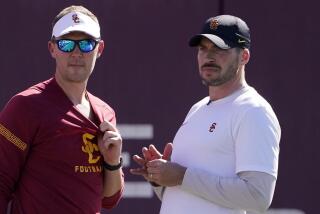The game’s other score
Out stepped the USC Trojan Marching Band onto Cromwell Field, a flood of musicians wearing their trademark sunglasses and short sleeves under the Southern California sun. Standouts in Trojan cardinal and gold, they swung trombones and trumpets in unison as the drum line rumbled with all the flash of Los Angeles’ hometown team.
At the same time 2,200 miles away, in wintry Ann Arbor, the Michigan Marching Band practiced last Thursday inside the heated, fluorescent-lighted Oosterbaan Field House, all Wolverine blue and maize, high-stepping with choreographed precision, clashing cymbals, awash in their university’s rich musical tradition and Big 10 style.
In the world of collegiate marching bands, these two are the powerhouse equivalents of the football teams they cheer on. Both practice incessantly. Both bring tens of thousands of fans to their feet in song and chants. And each vows to outplay the other at the 93rd annual Rose Bowl game.
But that’s about where the comparisons end between the 260-member USC band and the 271 players from the University of Michigan.
When the musically inclined Wolverines and Trojans step out onto the field, their styles are as different as their native climates, and their rivalry mirrors that of their highly ranked football teams. Michigan loyalists call the USC band freewheeling and brash. USC fans describe the Michigan band as traditional, too much like other bands.
“We want to go out and take the Rose Bowl. We don’t even want to hear them play,” Robert “Lenny” Millan, 21, a USC drum line section leader from Norwalk, said as he prepared for a practice.
A Michigan clarinet player expressed a similar sentiment, albeit in a more charitable tone.
“We always want to be better than the USC band, just because we have very high standards for ourselves,” said Lauren LaCross, 20, of Midland, Mich., after finishing eight hours of rehearsal.
Their directors downplay the competitive nature of their band members.
“To say it’s like the teams, I’m going to say no, because there’s no one keeping score,” said longtime USC band director Arthur C. Bartner, who earned his undergraduate, master’s and doctoral degrees at Michigan’s music school.
“I think it’s more a matter of pride,” he said. “We go out and we want to have the best show -- and Michigan, they want the same.”
Both bands know that on Monday, they must play and march at the absolute top of their game.
Participating in the Rose Parade and Rose Bowl game, after all, is a pinnacle performance for collegiate marching bands. Part of the halftime show is televised, unlike most of the other bowl game shows.
“It’s a huge deal. We’re really pumped right now,” said Michelle Smith, 21, who plays piccolo in the Michigan band.
The anticipation is even keener because Michigan has played in the Rose Bowl nearly as often as USC, most recently in 2004, when it lost to USC, and in 2005, losing to Texas. Last year, USC lost to Texas at the Rose Bowl in the national championship game.
For their halftime showpieces, Michigan band will feature a Led Zeppelin theme, including a “Black Dog” and “Kashmir” medley and “Stairway to Heaven.” The USC show will include “Snakes on a Plane,” a number from the summer’s cult horror film.
Michigan’s Jamie Nix, who at 34 is young to be leading a big-name collegiate band, took over as director in 2001 and has injected youthful energy -- more rock music, a playful “Monty Python and the Holy Grail” spinoff -- into the band performances. It also plays jazz and classical music, wrapping Hector Berlioz’s “March to the Scaffold” into its Iowa halftime show.
An Alabama native, Nix earned his master’s degrees in trombone performance and conducting at Michigan and played in the university orchestra.
As for his critique of the USC band, Nix said teasingly, “They just play that same song much too much,” a reference to the Trojan fight song, “Tribute to Troy.”
“One thing that separates us from most bands is our sound,” he said. “We focus on our sound a lot to get a deep, dark, rich sound. We have to be loud, because the Michigan stadium seats 110,000 people. But that’s not our focus, to be loud.”
Some Michigan players are blunter: USC is just too darn loud. “They play over virtually every band they play against,” LaCross said.
USC doesn’t see it that way.
“We have yet to see a band that can play as loud as we can,” said USC band student manager Julie Mattson, 22, a clarinet player from Eagan, Minn.
“We’re kind of in your face, always. Either you love us or you’re going to hate us,” said Brandon Effinger, 22, of Los Angeles, a USC trombone section leader.
The USC band has even gone Hollywood. It scored a Top 10 hit after Mick Fleetwood saw USC play Ohio State in the Rose Bowl and chose the band to accompany Fleetwood Mac on the 1979 song “Tusk.” It has appeared in a number of films and performed at two Academy Awards ceremonies as well as at the 2004 Grammy Awards.
Much of the band’s energy emanates from Bartner, 66, a New Jersey native who remade the band after arriving at USC from Michigan in 1970. At first, he tried to do things the more disciplined Michigan way, but it wasn’t working.
He sought counsel from the late Marv Goux, then a USC assistant football coach.
“He was the one who taught me we have to run it like a football team,” Bartner said.
So rehearsals became pep rallies, performed on Cromwell Field across the street from football practice. Again and again during rehearsal last week, Bartner directed his band to turn toward the football team and to play -- that song again -- “Tribute to Troy.”
He is unapologetic about his band’s reputation for playing loud and often. “This is how I run my band,” he said. “There’s no reason why they can’t play as loud and as often as we do.”
The Heisman Trophy of the collegiate band world is the Louis B. Sudler Trophy, awarded each year to the band selected by college band directors for a tradition of excellence. No band can win twice.
Michigan was the first Sudler Trophy winner in 1982. UCLA took home the cup in 1997. USC has never won.
Band directors hesitate to rank bands publicly, although the Ohio State marching band is widely considered one of the top two or three nationally. In fact, Bartner said his favorite band -- after USC’s -- is Ohio State’s, which won the Sudler Trophy in 1984.
Jon Woods, the Ohio State band director, said that although Big 10 schools of the Midwest historically have boasted strong bands, “we’re now in a period where the Pac 10 has some fine bands. USC, Washington, UCLA, Cal Berkeley.”
Woods commends Michigan’s band for maintaining its traditional pregame high-marching style while switching to a more contemporary style at halftime. The USC band, by contrast, uses the same marching style in pregame and halftime shows and is more Top-40 oriented, Woods said.
Embedded in the bands’ psyches is the same intense desire to give their teams the musical jolt to win games.
“It seems like our band never stops cheering,” said Effinger of USC.
Michigan players said that when the pressure mounts, it’s not so much about music as it is about cheering.
“We are the No. 1 Michigan football fan,” LaCross said. “When we’re in a rut, when we’re down 14 points, we’re all screaming as loud as we can. We’re screaming our hearts out.”
More to Read
Go beyond the scoreboard
Get the latest on L.A.'s teams in the daily Sports Report newsletter.
You may occasionally receive promotional content from the Los Angeles Times.










